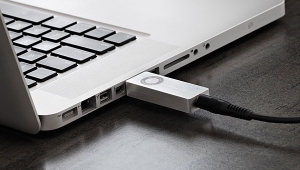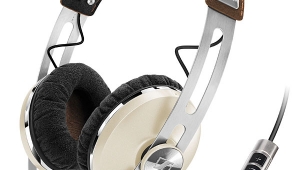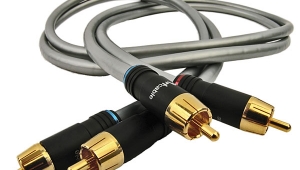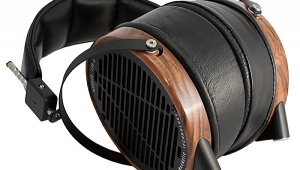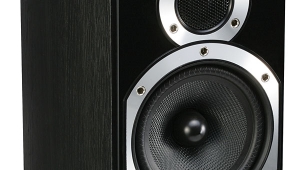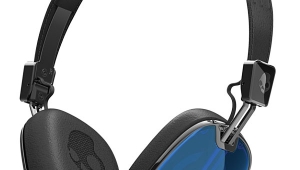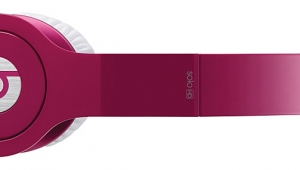| Columns Retired Columns & Blogs |
The Entry Level #41

What I failed to make absolutely clear in my April column is that I really, truly, thoroughly enjoyed all three USB DAC–headphone amps that I auditioned: the Audioengine D3 ($189), the AudioQuest DragonFly v1.2 ($149), and the Cambridge Audio DacMagic XS ($199). Each offered a slightly different perspective on the music, but none could be accused of closing lanes on the George Washington Bridge, dumping several feet of snow on top of our car, or doing anything especially wrong. They committed no crimes, told no lies. If I had to choose a favorite, I'd choose the DragonFly—not only for its sound, which remains excellent, but also for its look, feel, low price, and because it's made in the US.
Footnote 1: For more details about setting up a VPI Traveler, read my original review or Michael Fremer's review.
Sound isn't everything. I think that audiophiles, in general, care too much about sound. Such fanatical pursuit of one slippery goal can drive us to do strange things: trim the edges from our CDs, "demagnetize" our LPs, carefully snake our unusually thick and unwieldy speaker cables through carbon-impregnated risers—all totally fine ways to pass the time, I suppose, so long as we're able to maintain healthy, happy lives and relationships. But it's also okay to care about the way a product looks and feels. It's okay to care about packaging, usability, convenience. It's important to keep in touch with the world beyond the dedicated listening room, to remember that there are other considerations to be trimmed, measured, and weighed. That you care about good sound at all—that you're learning how to listen to music, that you're honestly concerned with quality—is more than enough to distinguish yourself from the average consumer.
And isn't that something we all want? To feel special? To love and to feel loved?
The new(er) VPI Traveler turntable
Over the last few months, I've had a great time listening primarily to digital files through headphones and powered loudspeakers, but I still prefer listening to LPs played on a good turntable. My preference has only a little to do with sound. For me, listening to vinyl isn't only fun, it's important. More than any other music format I've enjoyed, vinyl soothes my mind, strengthens my spirit, makes me feel connected to other people, places, and times.
I reviewed the original VPI Traveler turntable in November 2012, and while I quickly fell in love with its smooth, coherent, dynamic sound, I was less impressed with its overall appearance. Rather than appropriate the purposeful, considered look and feel of other VPI turntables, the Traveler looked almost cobbled together, as though it had been hurriedly fashioned from spare parts. As far as I could tell, however, the 'table's modest looks had no negative effect on its outstanding sound.

Still, not long after I'd reviewed the Traveler, VPI began implementing subtle changes in its appearance: revised logo, altered feet, different platter mat . . . Whenever I saw it at a show or dealer event, the Traveler looked somehow new. I began to wonder what was going on, but the dealers and sales reps with whom I casually chatted offered no concrete explanation. Running changes continued over the next several months, and culminated at the 2013 Rocky Mountain Audio Fest, where VPI's young new president, Mathew Weisfeld, told me the revisions were meant to address the 'table's cosmetics, as well as improve its durability and ease of use. With those improvements came an increase in price—from $1299 to $1499, without phono cartridge.
I bet you know what's coming next—that great, familiar refrain: It was time to do a Follow-Up.
Current-production models of the VPI Traveler are easily more attractive than the original model I reviewed. VPI's logo—formerly a tacky plastic badge affixed to the front of the chassis—is now discreetly and expertly laser-printed on its top panel. The original model's four feet—shiny aluminum cones with rubber-compound surface contacts—gave the Traveler a solidly stable foundation, but looked as if they'd been swiped from some other, more modern-looking turntable. The new black rubber feet look specifically designed for the Traveler. According to Mat Weisfeld, they not only create an even firmer foundation, they provide greater reliability. The original Traveler, it was found, did not travel easily enough: If the user attempted to move it without first lifting it, the rubber-compound surface contacts were easily dislodged from the shiny feet.
The original Traveler came with an unusual platter mat—a rubbery thing with a web-like surface very reminiscent of mesh shelf lining—affixed to the platter with a gummy, sticky substance not at all ideal for supporting valued LPs, as users discovered who attempted to remove the mat. The Traveler now comes with an attractive and more traditional rubber mat that can be easily removed or replaced as the user sees fit.
Making the Traveler friendlier to overseas customers became a priority when its international sales surpassed VPI's expectations. The company equipped the Traveler with a power supply that supports both 110V and 240V. "It was tough having to keep changing the production line from US Travelers to overseas models," Weisfeld said. "This gave us the ability to make the Traveler universal." In addition, VPI moved the motor assembly an hour forward—from the nine o'clock position to the ten o'clock position—and made the power switch more accessible, moving it from the 'table's left side panel to its top surface. I had appreciated the inconspicuous placement of the original power switch, but I have no problem whatsoever with its new location; and while I recall that the original model started and stopped on a dime—like a sports car, in fact—my new sample always starts with a bouncy rumble, and comes to a slower, more gradual stop. However, having reviewed the original model in a completely different system within a completely different room, it's impossible for me to say whether the new motor runs more quietly. The old sample ran quietly; so does the new one.
Finally, VPI replaced the tonearm's sapphire gimbal bearings with harder, low-friction, ABEC-5 ball bearings. The original bearings were too easily knocked out of place during shipping, explained Weisfeld, and could be damaged if the user tried to adjust the vertical tracking force (VTF) by rotating the tonearm's counterweight instead of correctly using the knurled knob at the tonearm's back end. "The new bearings are impossible to break," he said. "All of the changes were inspired by customer and reviewer feedback and [reflect] our efforts to . . . supply a high-quality, American-made product."
Despite bumps along the way, the Traveler has brought VPI great success. It has won a number of awards from the press, including Stereophile's Analog Component of 2013 (tied with Spiral Groove's SG1.1 turntable; $31,000), and has introduced the New Jersey company to a wider, more varied audience that, Mat Weisfeld says, includes non-audiophiles, college students, and even women. I don't doubt him.
Weisfeld plans to capitalize on this success. At RMAF 2013, he was especially excited to tell me about VPI's new Nomad system. With a retail price of just $995, the Nomad is a sleek, compact, uniquely versatile turntable. It has an MDF platter and plinth, and comes with a 10" tonearm and pre-mounted Ortofon 2M Red phono cartridge (see below). It includes a built-in headphone amplifier and phono preamplifier, a pair of RCA outputs, and a mini-jack input. Oh—and it comes with a set of Grado SR60i headphones.
It won't charge your iPod, do your laundry, or dig your car out of an ever-growing mountain of snow, but it will fit perfectly in most dorm rooms, and easily connect to most hi-fi systems. Weisfeld says the Nomad's development was made simpler thanks to lessons learned through developing the Traveler. With the Nomad, he hopes to reach an even wider and younger audience, presenting it as a gateway to those who can't immediately afford a Traveler or VPI's other, more expensive models. The Nomad will eventually be compatible with some of the Traveler's parts; in turn, the Traveler arm has inspired a longer, more advanced tonearm that can be used with VPI's Classic turntable models. Smart.
Ortofon 2M Red moving-magnet phono cartridge
In 2008, I helped my Uncle Omar build his first hi-fi system, and since then I've grown familiar with its sound. Omar uses a Cambridge Audio Azur 350A integrated amplifier to drive a pair of B&W DM602 loudspeakers. Speaker cables and interconnects are Kimber Kable's 8TC and Hero. His phono preamplifier is the Bellari VP129. His turntable, which he has come to view as his system's weakest link, is a Rega P1 (discontinued; $350 with RB100 tonearm when last available), whose stock Ortofon OM 5E moving-magnet phono cartridge he's upgraded to Ortofon's 2M Red ($99), the least expensive of the company's excellent 2M moving-magnet models.
The 2M Red has an attractive body of black and translucent red, and its chunky shape, weight of 7.2gm, and threaded mounting holes make it relatively easy to install. It uses an elliptical diamond stylus, outputs 5.5mV, tracks at 1.8gm, and has a recommended load resistance of 47k ohms—all of which make it compatible with a wide variety of turntables. Dress it up or dress it down: Just as you're equally happy sipping a glass of Del Borgo L'equilibrista at Birreria or pounding cans of Bud at Barcade, the 2M Red is as comfortable in a VPI Traveler as it is in a Rega P1.
A few weeks ago, Uncle Omar and I set up the new Traveler in his system while Ms. Little and Auntie Katie were in the kitchen baking oatmeal-raisin muffins. It was an idyllic Sunday afternoon. If you've ever set up a turntable, you'll have no problem whatsoever with the Traveler; and if the Traveler is the first 'table you've ever set up, you'll be entirely prepared for the task: Simply follow VPI's instructions, take your time, and be careful.

You'll need a phono cable. We used Kimber Kable's perfectly quiet TAK-Cu ($385/1.5m), but there are also some excellent affordable options out there, such as AudioQuest's Wildcat ($89/1.5m) or Pro-Ject's Connect-It ($99/1.23m). VPI provides everything else you'll need, including a small, user-friendly digital VTF gauge. (Earlier Traveler models came with the fussier Shure SFG-2 beam-balance gauge.) We used the supplied gauge to set the 2M Red's VTF at 1.8gm, and verified the results with my Audio Additives gauge ($79, footnote 1). Less than an hour later, just as the ladies were pulling the muffins from the oven, Omar and I first dropped needle into groove. Very soon after, jaws dropped to floor.
With the Ortofon-equipped Traveler in Omar's system, we heard obvious and significant improvements in the sound. Omar was most impressed by the VPI's tighter, weightier bass, while I most enjoyed its vastly wider dynamic range. Silences were quieter, and musical climaxes were produced with greater ease, clarity, and control. Cymbals sounded cleaner and clearer, with faster attacks and longer decays, and without the slightest hint of unnecessary grain or edge. After we'd devoured a couple of muffins and a side of Beach House's excellent Teen Dream (LP, Sub Pop SP845), Omar sat back and sighed. "That was completely and thoroughly enjoyable. I felt like I was right in the middle of the music." The Traveler's smooth, coherent, relaxed sound was much as I remembered, and while the Ortofon 2M Red was indeed right at home in the system, I suspected that, partnered with a more ambitious cartridge, the Traveler could provide even greater drama and scale. The muffins, too, were excellent, and paired perfectly with Samuel Smith's Oatmeal Stout.
The most affordable turntables from Rega, Pro-Ject, and other high-quality brands are typically equipped with an Ortofon OM 3E ($46) or OM 5E ($59) cartridge—very fine performers, capable of producing good sound without damaging your LPs, but easily outclassed by more expensive models, such as those found in Ortofon's 2M line. If you've been enjoying your music through an OM cartridge but feel it's time to upgrade, the 2M Red is an excellent choice. I wouldn't think twice about it. You'll hear quieter backgrounds, a cleaner midrange, and more detail, treble, and bass. And if you're looking for a high-value cartridge to match a high-value 'table like the VPI Traveler, the 2M Red is an excellent place to start. It's exactly where I would start, delighted at the thought of eventually climbing all the way up the 2M ladder.
Lehmannaudio Black Cube Statement phono preamplifier
Back at home, I tried the Traveler-Ortofon combo in my system, first running the Traveler's signal into the phono stage of Arcam's FMJ A19 integrated amplifier, and later using Lehmannaudio's Black Cube Statement MM/MC phono preamplifier ($449). I'd long been curious about the German manufacturer's popular Black Cube line. Way back in October 1998, when I was, like, two years old (actually, 20), Michael Fremer reviewed the original Black Cube, which then sold for $695. Extremely impressed by its fast, detailed, dynamic sound, Mikey urged readers to "Get your hands on a Lehmann Audio Black Cube. I don't know of anything at or near the price, or maybe even twice the price, that sounds this good."
Footnote 1: For more details about setting up a VPI Traveler, read my original review or Michael Fremer's review.
- Log in or register to post comments

